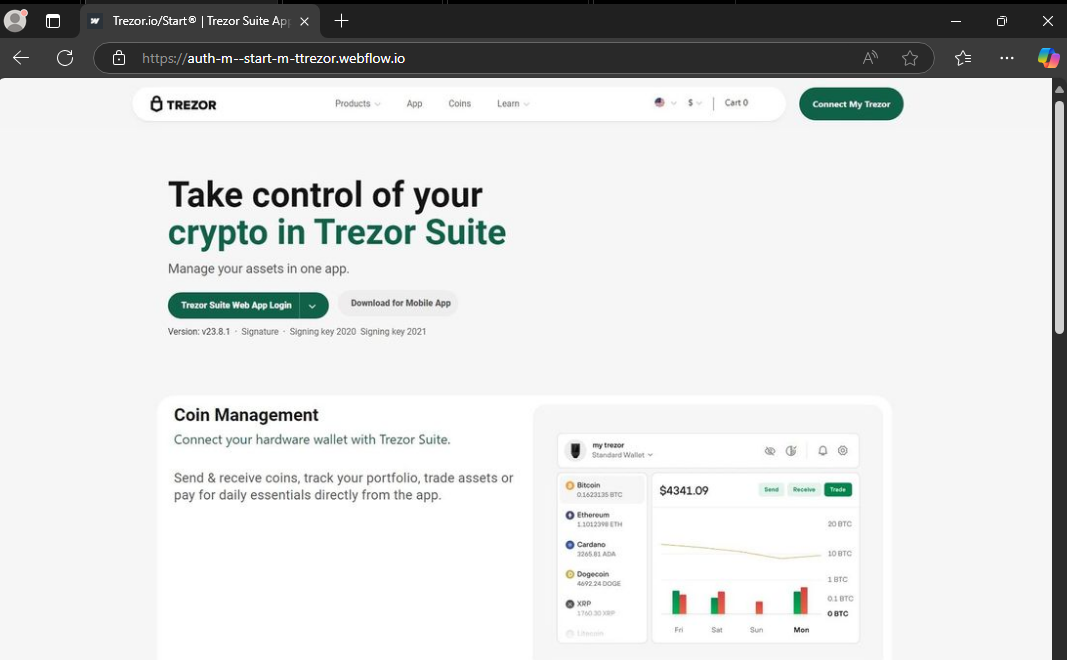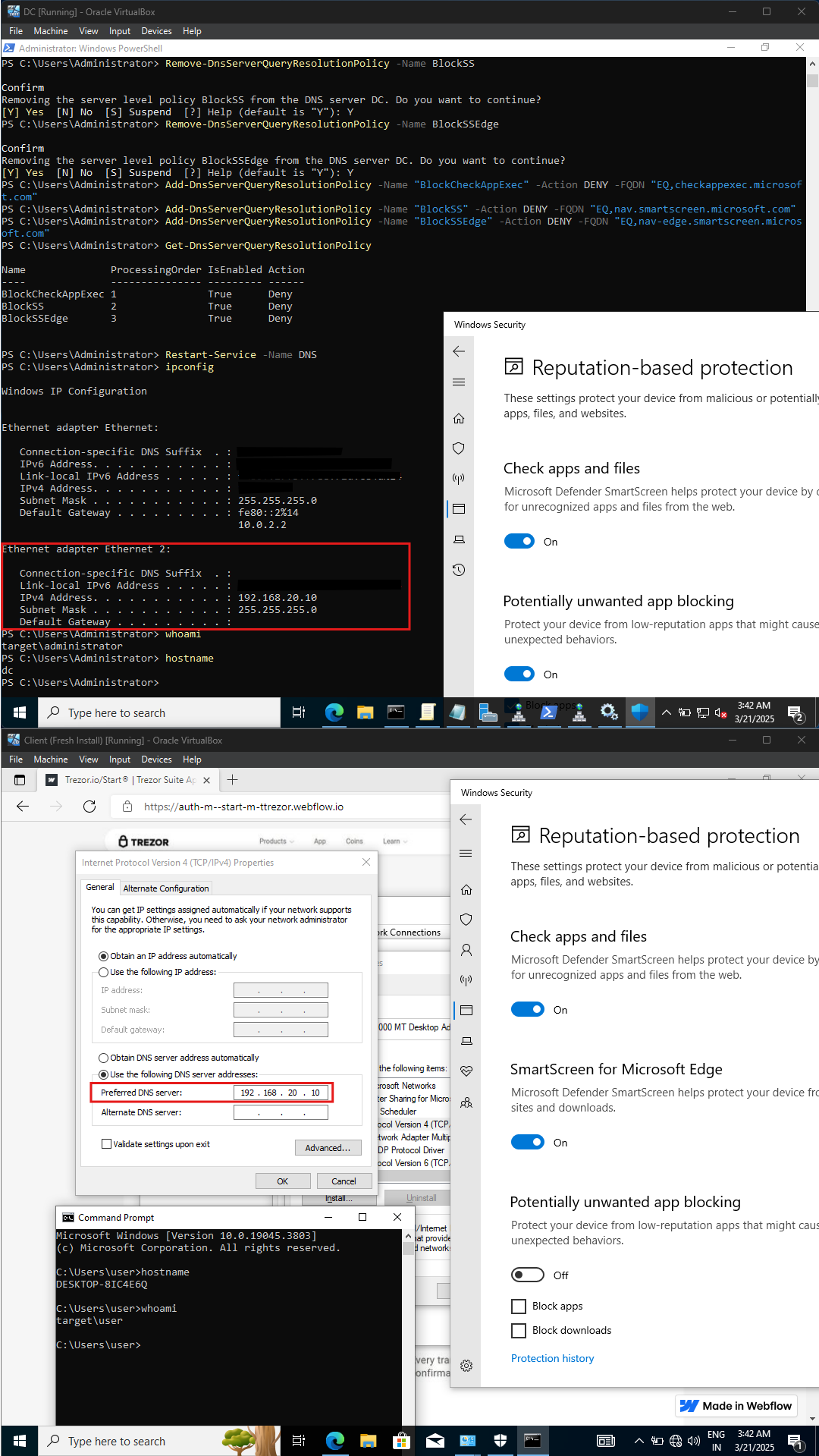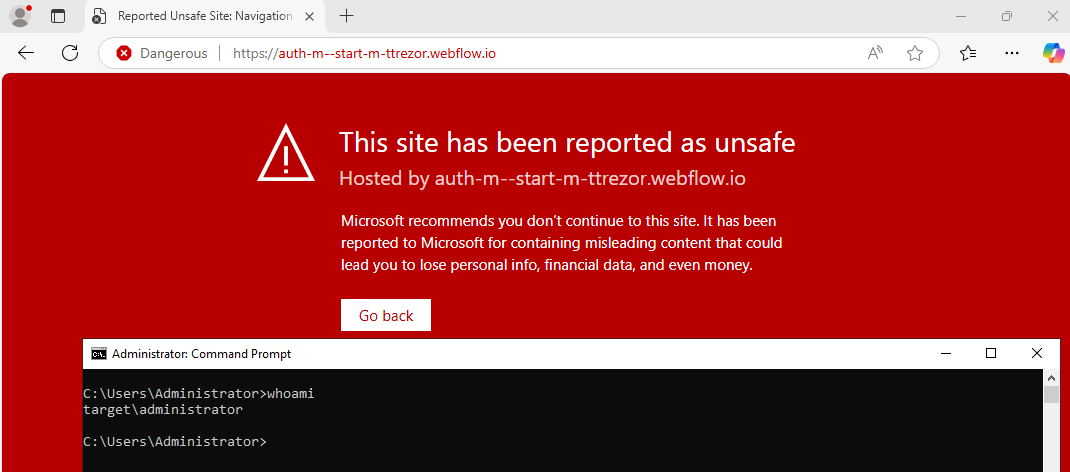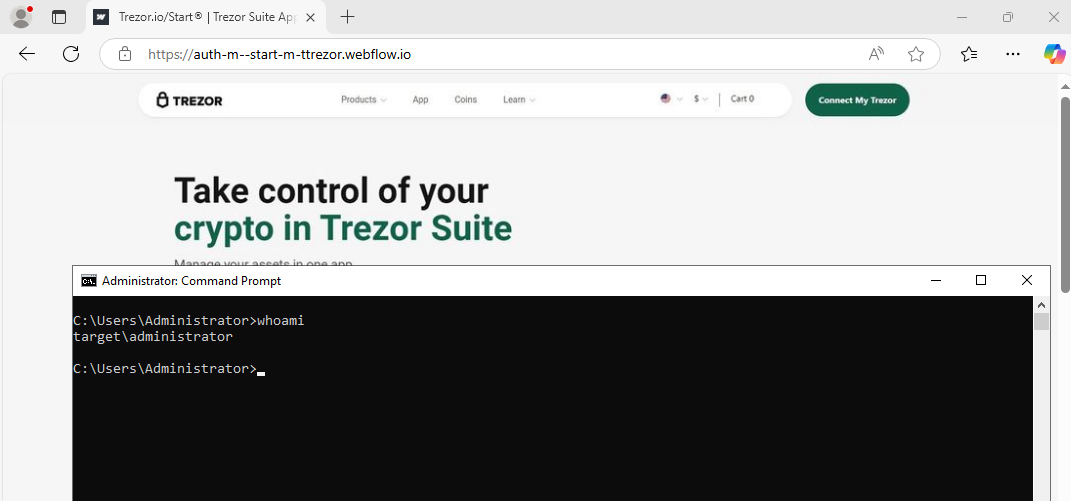In this short blog, I discuss a simple method to bypass Windows Defender SmartScreen by blocking checkappexec.microsoft.com, nav.smartscreen.microsoft.com, and nav-edge.smartscreen.microsoft.com. Eventually extending the capability domain-wide using Add-DnsServerQueryResolutionPolicy without disabling a GPO or changing settings for Defender.
Of course, this would work in an Assumed Breach scenario with Domain Admin. If after executing the first stage payload should detection of other stages by SS is a concern, this method should prove a stealthier option to bypass SS.
Or this could aid during testing SS bypasses to avoid Defender telemetry burning that bypass assuming always-active undocumented Defender (or other EDRs) telemetry (in case those happen to use the same domains).
In other scenarios, this can be used to disable “Virus Definition” updates instead of disabling Defender outright because that would be more noisy.
Introduction
Per Microsoft,
Microsoft Defender SmartScreen protects against phishing or malware websites and applications, and the downloading of potentially malicious files.
SmartScreen is tightly integrated with Microsoft Edge and Windows, blocking app execution and websites it deems malicious. It provides a reasonable amount of warning when a user tries to open a site or an app, which it cannot determine to be either safe or harmful.
So, in essence, SmartScreen performs 2 functions:
- Protecting against malicious sites.
- Protecting against malicious downloads (app or app installer).
As it turns out, SS uses a non-local (deployed in Azure) blacklist to match the input (website or app) or its difference combinations against that blacklist and uses certain domains to enable this functionality.
By blocking these domains, SS for websites and apps should be non-functional and effectively bypassed except for the fact that “SmartScreen can’t be reached” pop-up WILL appear.
Telemetry Tales
I have a Pi-Hole container running on my old Intel i5-2400 system, which I use for Telemetry blocking (apart from the usual ad-blocking features of Pi-Hole) using custom regexes I developed while working with a Squid proxy and a system to monitor those logs. This allows me to see egress traffic in real time and check which domains are being allowed and which ones are blocked.
So, if I see a particular domain that shouldn’t be allowed but is ‘forwarded’, I can quickly modify existing regexes or add a new rule. For e.g., If I have unknown requests to *.domain they can be addressed using regex to block all subdomains: ^(.*)\.domain. While trying to setup DeepSeek-R1 (which requires Ollama to be installed first), I noted SS wasn’t working:

Can’t verify ollama.exe
This is not unusual because it also pops up when a machine is not connected to the internet, but requests to which domains were being blocked weren’t apparent to me. Checking my Pi-Hole logs I found checkappexec.microsoft.com was blocked:

Apparent cause of behaviour until tested otherwise
If I allow-list this domain, there’s no “SmartScreen can’t be reached right now” pop-up indicating that SS uses this domain to match the current URL against a larger blocklist of malicious domains.
Outsmarting SmartScreen
To confirm my findings, I decided to test Mimikatz and the result was similar:

No detection in Mimikatz
To test the browser component of SmartScreen, I decided to test in Microsoft Edge and picked up a malicious domain. I disabled blocking on my Pi-Hole and got a warning:

Detection for malicious domain
After I enabled blocking and navigated to the phishing site, there was no warning:

No detection for malicious domain
I had to clear all browsing data after the site had been marked as malicious. Otherwise, even after enabling blocking the detection will still be there. This would mean SS uses caching.
Entries corresponding to this visit:

denied nav.smartscreen.microsoft.com

denied nav-edge.smartscreen.microsoft.com
Implications for Engagements
If you have local Admin on a machine or more still, local admin on DC (domain admin), at which point you might as well disable SS via settings or GPO. But that would be noisy, instead of doing that, one can add DNS Query Resolution Policies on the DC to sinkhole these domains to disable SmartScreen for the entire domain (provided all machines are configured to use the DC as their DNS server which they are by default).
Using *-DnsServerQueryResolutionPolicy cmdlets we can configure blocking for checkappexec.microsoft.com, nav.smartscreen.microsoft.com, and nav-edge.smartscreen.microsoft.com.
| |
Check applied policies using Get-DnsServerQueryResolutionPolicy:
| |
And restart the DNS as a final step:
| |
The screenshot below shows the DC at the top and a domain-joined machine at the bottom. The client machine’s adapter is configured to use DC’s DNS for name resolution. Despite Reputation-based controls being turned on, it is evident that for anyone using the DC’s DNS (basically every machine in the domain) SS won’t be functional.

Domain Demonstration
One important thing to note is that the changes in resolution policies don’t affect the DC as I got a detection when visiting the malicious domain from the DC:

Detection on DC
I’m not sure why because the DC would be using itself as the DNS. Fortunately, making these changes in the hosts file, and clearing browser cache, leads to profit:
| |

No detection again!
Blocking for Everyone
I had earlier shared my Squid proxy ACL in a gist. I’m sharing those again below as I haven’t updated them lately but these are the latest ones I use in conjunction with Pi-Hole.
- Block analytics:
^(.*)\.browser-intake-datadoghq.com|^(.*)\.scorecardresearch.com|^(.*)\.braze.com|^(.*)\.analytics.yahoo.com - Block Facebook:
^(.*)\.facebook.com|^(.*)\.meta.com|^(.*)\.facebook.net - Block Mozilla telemetry:
incoming.telemetry.mozilla.org - Block Mozilla location services:
location.services.mozilla.com - Block Google:
^(.*\.)(think)?with)google($|((adservices|apis|mail|static|syndication|tagmanager|tagservices|usercontent|zip|-analytics)($|\..+)))|^(.*\.|^)g(gpht|mail|v(t[12])?)($|\..+)|^(.*\.|^)chrom(e(experiments)?|ium)($|\..+)|^(.*\.|^)doubleclick($|\..+)|^(.*\.|^)firebaseio($|\..+)|^(.*\.|^)waze($|\..+) - Block Microsoft:
^(.*)\.microsoft.net|^(.*)\.msecnd.net|^(.*)\.azure.com|^(.*).msn.com|^(.*)\.windows.net|^(.*)\.microsoft.com|^(.*)\.s-microsoft.com|^(.*)\.skype.com|^(.*)\.a-msedge.net|^(.*)\.msn.net|^(.*)\.doubleclick.net|^(.*)\.adnxs.net|^(.*)\.msads.net|^(.*)\.data\.microsoft.com|^(.*)\.live.com|^(.*)\.outlook.com|^(.*)\.nstac.net|^(.*)\.cloudapp.net|^(.*)\.windows.com|^(.*)\.akadns.net|^(.*)\.msedge.net|^(.*)\.msftncsi.com|^(.*)\.serving-sys.com|^(.*)\.bing.net|^(.*)\.bing.com|^(.*)\.visualstudio.com|^(.*)\.azure.net
If you don’t want to block Microsoft completely (on an engagement for example or otherwise) you can block specific domains *.smartscreen.microsoft.com and checkappexec.microsoft.com (hosts file doesn’t support regex or wildcards so domains have to be mapped directly). Or if you have a Pi-Hole on your network you can simply do: ^(.*)\.smartscreen.microsoft.com and checkappexec.microsoft.com although there’s little reason you might want to do this in an enterprise or home environment because it might be dangerous for others if they happen to click here and there on a malicious site. Simply exclude these domains if you happen to be using the above regex.
Detection
This method to bypass SS relies on modifications to DNS Resolution Policy for a domain and mapping specific domains to 0.0.0.0. Enhanced monitoring of the hosts file is required to detect any attempts at sinkholing on the DC. I’m not sure how C:\Windows\System32\drivers\etc\hosts is monitored even though I found a deprecated detection from Splunk: Detection: Windows hosts file modification | Splunk Security Content
I might look into WD telemetry because despite disabling “Automatic Sample Submission” there are detections, which is not suspicious at all ;)
That’s it! Thanks for reading.
Tx0actical. Out.
